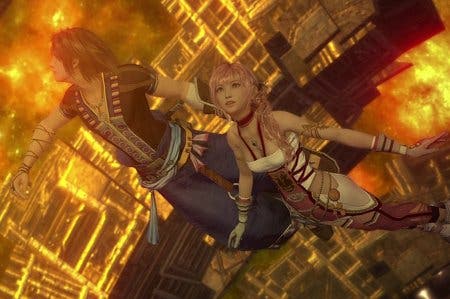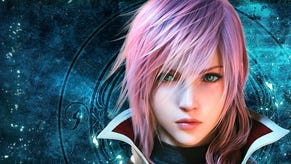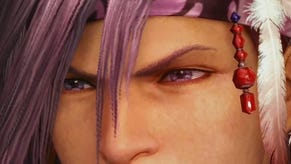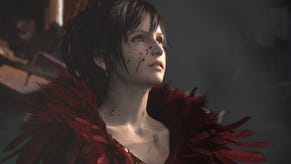Face-Off: Final Fantasy 13-2
PS3 comes out on top as Lightning strikes twice.
| - | Xbox 360 | PlayStation 3 |
|---|---|---|
| Disc Size | 7.7GB | 14.06GB |
| Install | 7.7GB (optional) | - |
| Surround Support | Dolby Digital | Dolby Digital, DTS, 5.1LPCM |
Final Fantasy 13 remains a technical marvel on PS3, but also a relative disappointment for Xbox 360 users who tolerated comparably worse performance, lower native resolution, and sub-par video quality for cut-scenes. The arrival of Final Fantasy 13-2 two years later brings with it a promise of change, where factoring in the development of both versions from the very start addresses many of these criticisms, but the question is whether console parity can be a reality this time around.
With the PS3 version of Final Fantasy 14 delayed until next year, this is the first chance we've had to see the changes made to Square Enix's "Crystal Tools" engine on home consoles since Lightning's first adventure. The improvements were already clear in our recent dissection of the demo, with the 360 version's native frame-buffer being bumped up from the 1024x576 value in the original to match the 1280x720 resolution of the PS3 version. To sweeten the deal further, both versions also benefit from the application of 2x MSAA (multi-sample anti-aliasing), which brings the image quality of each to an equivalent standing.
This inadvertently puts to right another major qualm levelled against the original: namely, the dithered alpha-to-coverage effect on hair. The "feathered" look used for practically all the characters' hairstyles is apparently a preference for lead character designer, Tetsuya Nomura, but did result in some nasty pixel crawl when combined with the lower resolution of the 360 version in the first game. Here, the look is still somewhat distracting on both consoles, with the pixellation on each strand being especially easy to pick out during the game's many zoomed, close-up shots of character's faces, but it's nowhere near as egregious as before.
Final Fantasy 13-2 looks absolutely stunning in every other regard, with some impressive use of light shafts around characters and trees when looking up at Cocoon's glow, and spectacular bloom effects around the Oerba level in particular. This is true of both versions, and there's very little to distinguish between either visually when it comes to matching frames in a like-for-like manner during cut-scenes, dungeon traversal or battle. You can see this for yourself in the range of assets we've prepared from both versions of the game, dotted throughout this article.
Image Quality and FMV: Can 360 Compete This Time?
It seems the core texture assets, particle effects and water shaders are identical across both platforms too, with texture filtering also now set to a similar quality on each. However, one of the bigger points of distinction we noticed in visual terms is the way shadows are rendered, with the 360's looking much fuller in places with fine detail. This is mainly perceptible on points such as tree branches or fingers, where the PS3's can look considerably different - although which implementation you prefer may be down to personal choice. This is in contrast to the scenario laid out in the first game, where the PS3 projected shade in areas where it remained entirely absent on 360, giving it a lighter, pared-back look (owing to an offset shadow bias). Fortunately, this time the visual tone of the environments appear to be much more consistent between the two versions.
"Final Fantasy 13-2's core texture assets, particle effects and water shaders are identical across both platforms, with texture filtering also now set to a similar quality on each and just minor differences in shadow rendering."
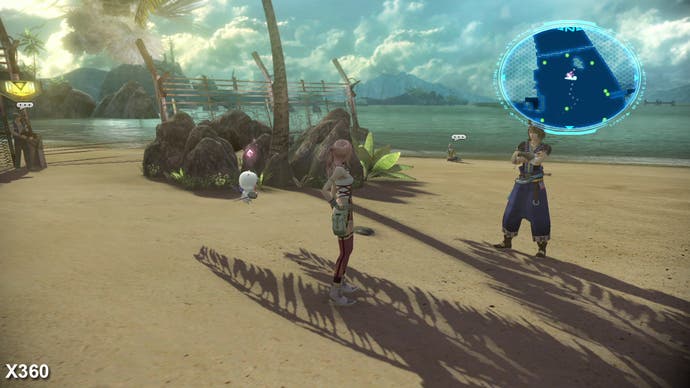
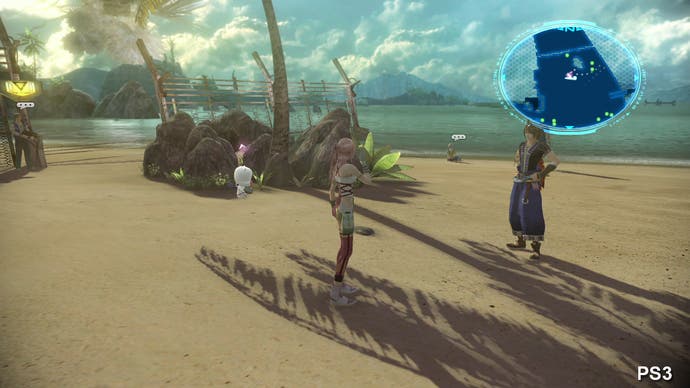

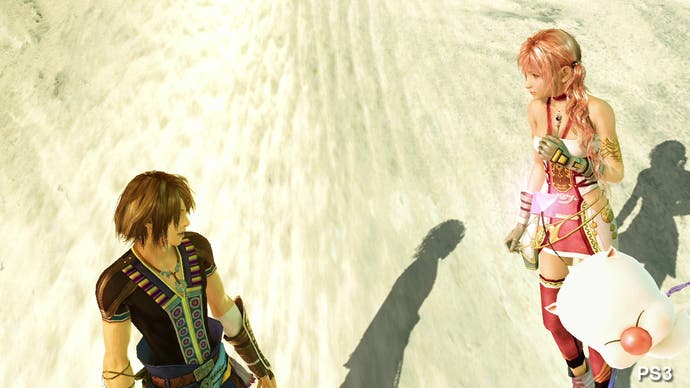
We noticed the shadow system suffers from some curious glitches too. Strangely, the filtering cascade on shadows around town areas like New Bodham will only be present when running from the direction of the sun, but never when running towards it. Essentially, this means a southward walk results in lower-quality, blocky shadows being produced everywhere, while doubling back on yourself allows the higher-quality shadows to pop in from a distance. This is a phenomenon common to both consoles, and given that the last game suffered from a glitch on 360 where all offset shadows clipped with the environment, this perhaps reveals a weakness in the engine.
On the topic of towns, their inclusion this time around has spurred Square Enix on to offer up more advanced AI routines for the NPCs that populate them. No doubt this puts an extra strain on performance, but where Final Fantasy's linear dungeon crawl could be a solitary experience, most areas throughout this sequel are filled with characters that have their own preset routines. It's more than a superficial touch too, as they'll talk to Noel when idle, grant quests, and also react with according aggression when an enemy pops up - immediately engaging in battle. This is a nice dynamic that creates the illusion that there are agendas in the game-world besides your own.


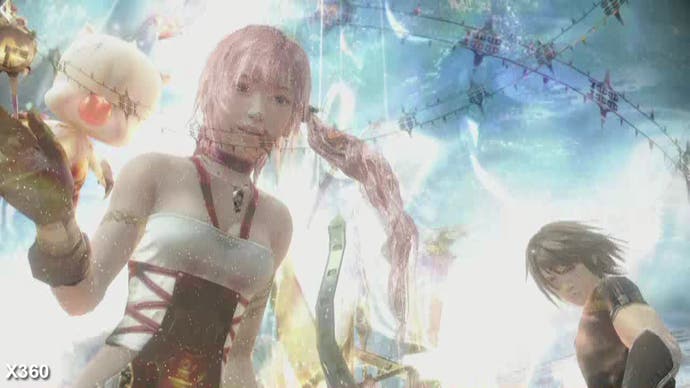

Another area in dire need of addressing was, and remains, the frankly atrocious FMV quality on 360, which continues to use the Bink codec in order to fit all its video content on a single DVD. Thankfully, Square Enix has side-stepped the severity of the problem by making sparing use of pre-rendered media, with a three-minute opening CG cut-scene taking up a majority of the space allocated for video. The layer of "grain" post-processing used for the black and white sections in this video causes the most prominent manifestations of compression artifacts, and will likely be noticed by even the most undiscerning player.
"Improvements to the engine have levelled image quality in many regards, but there's still a gulf in quality when it comes to the FMV video, which remains an issue on Xbox 360."
There are instances of video throughout the game which also serve to remind us of this compromise to quality. Outside of the lengthy introductory video, flashback video sequences are composited over the top of gameplay during the first few hours of the game to serve as a kind of memory jog for fans of the last game - a stylish technical feat which evidently requires further compression to the content to work. Loading a save also kick-starts a short video sequence which splices together the most recent events according to your chapter progress - a helpful reminder for the intermittent player which plays over the loading screen.
Having these videos run over the top of other processes has necessitated far more aggressive compression methods on both consoles though, and once again the artifacting is considerably more impactful on the on 360 as a result of its use of the Bink codec. We're a little disappointed that the PS3 version couldn't utilise the greater capacity of the Blu-ray here to improve quality further, with the original game's 33GB of overall video data being reduced to around 8GB in the new game. However, clearly this wasn't an option when it came to running these videos in tandem with actual gameplay and loading screens.
Performance Analysis
As far as performance goes, comparing like-for-like cut-scenes and traversal around towns or dungeons reveals a marked lack of optimisation on both consoles - especially in large industrial hubs like Bresha where the combination of rainfall and multiple NPCs can drag either version down to 20FPS. The frame rate also tends to fall between the 20 and 30 mark during cut-scenes, with the "cinematic action" ones featuring QTEs being particularly challenging.
Regular actions, such as travelling down a boarded pathway to New Bodham, also result in a similarly jarring impact on performance, although we do find that the PS3 tends to command the more consistent refresh in frame rate. The rule of thumb, regardless of where you are, is that the PS3 will always hold out at up to 5FPS above whatever the 360's pushing out, with the best case scenario being that they'll match each other.
The causes for these drops seem to be mostly linked to multiple light sources and particle effects, as you can see in the scene where Noel and Serah are travelling to the Historia Crux for the first time, with lighting being cast from almost every angle. This also rings true during the "Prelude" section of the game with Lightning battling while riding on horseback, during which frames are dropped consistently whenever magic spells are cast by the enemy. Fortunately this whole sequence is a one-off in terms of placing a strain on either console during battle.
It's an odd reversal of results, in fact, with almost every battle sequence - from quick scuffles against regular minions to protracted bouts against giant, otherworldly bosses - sailing smoothly at the game's target 30FPS on both platforms, while cut-scenes struggle. It's rare for the game to hiccup when put in these scenarios, even with every character on the battlefield casting spells in synchrony. It's of great benefit to the game's playability that this is the case though, as the pace of its battle system relies on quick and regular use of the Paradigm Shift mechanic in order to stay afloat in battle - a critical demand on controller response at points.
"The rule of thumb is that the PS3 will always hold out at up to 5FPS above whatever the 360's pushing out, with the best-case scenario being that they'll match each other."
One final aspect of performance worth pointing out relates to the game's loading times. Given that Final Fantasy 13-2 is now heavily menu-driven, with the Historia Crux serving as your main time-hopping hub, splash screens featuring its logo become a regular fixture during the run of play after selecting from the 30+ areas available. Climbing up to the 40-second mark in the case of travel to Bresha 005AF, these waits can be a nuisance when considering how the fragmented nature of the game demands that you switch between locations regularly in order to locate different artifacts, and then their corresponding gate.
Running the 360 version from a HDD install does afford the console a small advantage over the PS3 in this regard, with six seconds being shaved off the clock for most destinations. Similarly, selecting retry during battle or skipping a cut-scene is much faster when installed, which can help when "Locking" a level in order to replay events, for which you sometimes don't want to see the story being played out again and again.
Final Fantasy 13-2: The Digital Foundry Verdict
Taking all these points into account together though, there's no doubt that it's the PS3 version that we'd recommend if given the luxury of choice. With Final Fantasy 13-2, Square Enix has managed to pair the overall look of both versions very closely due to their matching framebuffers and identical assets and effects. As far as image quality is concerned, FMVs on the 360 still stick out like a sore thumb due to some extreme levels of compression, although this is made more tolerable by virtue of their infrequency. However, it's the edge in performance that the PS3 offers - usually ahead by 5FPS at any one time during town stages and cut-scenes - that makes it the version to vouch for.
Although the Crystal Tools engine once again favours Sony's console, we are nevertheless impressed that the gap has narrowed this time. If the rumours surrounding yet another entry in the Final Fantasy canon have any merit, we hope this is a trend that can continue once again before the generation comes to a close.
